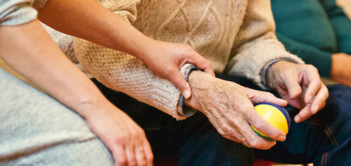My husband calls it Arthur’s disease – his version of “Arthur-i-tis.” That’s his attempt to make light of the pain and limitations of the chronic condition that affects nearly every move he makes – sitting, standing, putting on socks and shoes, using a computer or playing the piano.
In the United States, over 54 million people have arthritis – that’s approximately one in four adults. In people ages 65 or older, that number grows to nearly one in two (49.7 percent).
 Arthritis includes more than 100 different diseases and conditions that affect the joints. Arthritis causes aches and pains as well as swelling and stiffness around the joints. Specific symptoms vary by the individual and type of arthritis.
Arthritis includes more than 100 different diseases and conditions that affect the joints. Arthritis causes aches and pains as well as swelling and stiffness around the joints. Specific symptoms vary by the individual and type of arthritis.
The most common type is osteoarthritis, where cartilage (the tissue that cushions the ends of bones at joints) breaks down and wears away. Bones do not glide smoothly during movement. Instead, they rub against each other – in the hands, neck, lower back, knees, hips and/or feet. Other types of arthritis include rheumatoid arthritis, fibromyalgia, gout and lupus.
Effects on Daily Living
Arthritis can impair gait and balance, which can increase the risk of falls. Adults with arthritis are 2.5 times more likely to have two or more falls and experience a fall injury within a year.
Joint pain and movement limitations from arthritis can affect daily activities. For instance, people with arthritis may find it difficult to grasp small objects, reach above their head, sit or stand for more than two hours, or climb a flight of stairs. About 43 percent of adults with arthritis have activity limitations due to arthritis.
Five Tips to Consider
Here are five tips from the Centers for Disease Control and Prevention you can use to manage arthritis:
- Talk with your doctor. Early diagnosis and disease-specific prescription medications can be especially helpful for inflammatory types of arthritis, such as rheumatoid arthritis. Your physician can provide guidance about exercise, weight control and diet, pain, fall prevention and ways to handle physical limitations.
- Protect your joints. What you do each day can influence whether you develop arthritis. Sports injuries or repetitive tasks at work can affect your joints and make osteoarthritis more likely.
- Maintain a healthy weight. This will reduce stress on weight-bearing joints such as the hips and knees and can help prevent physical limitations. A weight loss of just 5 percent (about 12 pounds for someone who weighs 250 pounds) can help reduce arthritis pain.
- Be active. Being physically active can improve function, decrease pain and increase quality of life. There are recommended programs for people with arthritis, as well as physical activity guidelines to consider based on age and health status. Consult your doctor prior to beginning an exercise program.
- Participate in a self-management program. The Arthritis Self-Management Program and the Chronic Disease Self-Management Program include proven techniques so people can manage their pain and symptoms better.
When someone with arthritis is at risk for falls or needs assistance with daily care, ComForCare/At Your Side Home Care can help. Our in-home care services includes light housekeeping, personal care, companionship and transportation. Check out our downloadable: 50 Ways We Can Help.
![Duel-Logo-CFC-AYS[rgb]](https://blog.comforcare.com/hs-fs/hubfs/Duel-Logo-CFC-AYS%5Brgb%5D.jpg?width=525&name=Duel-Logo-CFC-AYS%5Brgb%5D.jpg)
